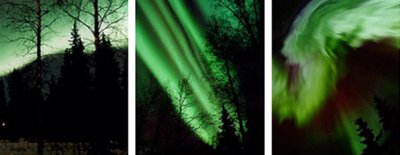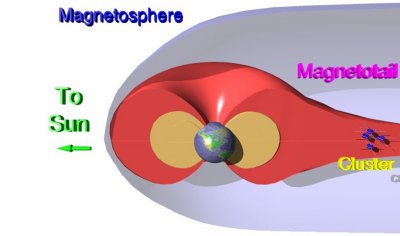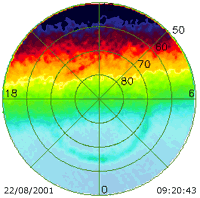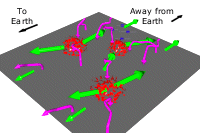Cluster finds new clues on what triggers space tsunamis
12 April 2007
In high-latitude regions like Scandinavia or Canada, auroras appear in many different shapes. The aurora in the early evening often forms a motionless green arc that stretches across the sky in the east-west direction (Image 1). But several times a year, such a static display suddenly changes to many colourful auroral forms dancing in the sky (Image 1). These sudden changes in aurora are the visual manifestation of space disturbances known as substorms. These perturbations can affect our daily lives, in particular by affecting GPS reception.Substorms revealed by auroral activity are in fact a consequence of the interaction between our Sun and the Earth's magnetic field. The Sun continuously expels a fast flow of particles, the solar wind, essentially consisting of electrically charged particles in a plasma state. The Earth's magnetic field is distorted by the solar wind to a droplet shaped magnetic bubble called the magnetosphere. On the nightside, the Earth's magnetic field is indeed stretched to a long distance tail, the magnetotail, much like the tail of a comet (Image 2).
Substorms are powered by an energy source in the magnetotail, where a large amount of charged particles reside and intense electric currents flow. However, the primary physical process responsible for substorms remains a mystery even after more than 40 years. Why? Because the substorm onset lasts 1 to 2 minutes and consists of 3 dimensional physical phenomena spread over nearly 150 000 kilometres, from 100 km altitude where auroral lights occur to 10's of Earth radii (or RE) away in the magnetotail. Trying to understand the substorm process with a single scientific spacecraft is like trying to predict the behaviour of a tsunami with a single buoy in an ocean. In other words, the simultaneous use of several satellites is necessary.
Currently there are two competing models to explain the substorm process: the Current-Disruption model (CD) and the Near Earth Neutral Line Model (NENL). As we will see, using data from the four spacecraft of the Cluster mission, a group of scientists from both sides of the Atlantic have recently reported that data collected in the magnetotail during a substorm are consistent with the CD model.
A substorm is in fact composed of different stages of development. Studying in details one of these stages enables to differentiate between these two models, at least for a particular case study. For example, in the late stage of substorm development, auroral disturbances move towards the poles, suggesting that the energy source for auroras and substorms moves away from Earth (Animation 1). Previous satellite observations have found that plasma flows in the magnetotail exhibit a reversal in direction during this late stage, from tailward to Earthward. Since plasma flow carries energy, the in-situ observation of such a flow reversal indicates the satellite's encounter of the region where, most probably, the primary substorm process occurs.
Previously, it was generally perceived that a flow reversal region is where magnetic reconnection occurs, that is to say where magnetic field energy is converted to particle energy, resulting in high-speed plasma flows.
Detailed analysis of data obtained by the Cluster satellites traversing such a region in the magnetotail has recently been reported by Lui et al. [2006]. Thanks to the unique capability of Cluster to perform simultaneous multipoint measurements, they were able to derive several physical parameters never estimated before for a flow reversal region. In particular, they compared the directions of the electric current and the electric field to identify effects related to the energy conversion from one form to another. When the current is along the direction of the electric field, magnetic field energy is converted to particle energy and is known as having a dissipation effect. When they are oppositely directed, particle energy is converted to magnetic field energy and is known as having a dynamo effect.
For this case study, the observed features associated with the flow reversal region are complex, consisting of both dissipation and dynamo effects in localized sites. This result is consistent with plasma turbulence excited by multiple sites where the local electric current is disrupted. This observed pattern was not predicted by previous models of magnetic reconnection but is in agreement with a numerical simulation on the development of plasma processes driven by strong electric currents [Lui, 2004]. Image 3 illustrates the complex magnetic field configuration in the flow reversal region. Animation 2 puts forward the idea that disruption of electric current occurs intermittently in several sites within the flow reversal region.
"These observed features are consistent with the current disruption model. However, it is unclear how general the above findings are. More events will be examined in the future," wrote Dr. Tony Lui, lead author of this study, published in Annales Geophysicae 09 August 2006. Tony Lui is a scientist of the Applied Physics Laboratory (APL) at the John Hopkins University (JHU), Maryland, USA and Co-Investigator on the RAPID high energy particles experiment of Cluster.
"The magnetic substorm phenomenon is a hot topic of research. This new result from Cluster on the subject will certainly contribute to the on-going scientific debate and foster research cooperation with scientists involved on the newly launched NASA THEMIS mission, a mission dedicated to substorms," says Philippe Escoubet Cluster and Double Star project scientist of the European Space Agency.
Lui, A.T.Y., Y. Zheng, Y. Zhang, H. Rème, M.W. Dunlop, G. Gustafsson, S.B. Mende, C. Mouikis, and L.M. Kistler, Cluster observation of plasma flow reversal in the magnetotail during a substorm, Ann. Geophys., 24, 2005-2013, 2006.
Contact
Main author
Tony Lui, JHU/APL, 11100 Johns Hopkins Rd, 20723 Laurel, MD 20723-6099, USA
Email: tony.lui jhuapl.edu
jhuapl.edu
Phone: +1 240 228 55 98
Web story authors
Arnaud Masson, SCI-SO division, RSSD, ESA, The Netherlands
Email: Arnaud.Masson esa.int
esa.int
Phone: +31-71-565-5634
Tony Lui, JHU/APL, 11100 Johns Hopkins Rd, 20723 Laurel, MD 20723-6099, USA
Web story editors
Philippe Escoubet, SCI-SM division RSSD, ESA, The Netherlands
Email: Philippe.Escoubet esa.int
esa.int
Phone: +31-71-565-4564
Arnaud Masson, SCI-SO division, RSSD, ESA, The Netherlands
Matthew Taylor, SCI-SO division, RSSD, ESA, The Netherlands
Email: Matthew.Taylor esa.int
esa.int
Phone: +31-71-565-8009






